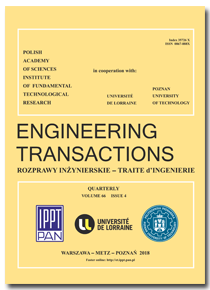10.24423/engtrans.152.2011
Mechanical Characterization of Steel for Fastening in a Wide Range of Strain Rate
References
EN 10263-4: 2003. “Steel rod, bars and wire for cold heading and cold extrusion. Part 4: technical delivery conditions for steels for quenching and tempering”.
M. A. Meyers, Dynamic Behavior of Materials, Wiley Interscience, New York, 1994.
J. E. Field, Review of experimental techniques for high rate deformation and shock studies, Int. J. Imp. Eng., 30, 725–775, 2004.
G. T. Gray III, Classic Split-Hopkinson pressure bar testing, [in:] ASM Handbook, Vol. 8, H. Kuhn, D. Medlin [Eds.], ASM Int., Materials Park Ohio 2000, pp. 462–476.
K. A. Hartley, J. Duffy, R. H. Hawley, The torsional Kolsky (Split-Hopkinson) bar, [in:] ASM Handbook, Vol. 8, H. Kuhn, D. Medlin [Eds.], ASM Int., Materials Park Ohio 1985, pp. 218–228.
S. Vaynman, M. E. Fine, S. Leeb, H. D. Espinosa, Effect of strain rate and temperature on mechanical properties and fracture mode of high strength precipitation hardened ferritic steels, Scripta Materialia, 55, 351–354, 2006.
T. Nicholas, A. M. Rajendran, Material characterization at high strain-rates, [in:] High Velocity Impact Dynamics, J.A. Zukas [Ed.], Wiley, New York 1990, pp. 127–296.
C. Albertini, M. Montagnani, Testing techniques based on the split Hopkinson bar, Institute of Physics Conference series No. 21, pp. 22–32, London, 1974.
C. Albertini, M. Montagnani, Waves propagation effects on dynamic loading, Journal NED 37, pp. 115–124, North Holland Publishing Company, 1976.
R. M. Davis, A critical study of the Hopkinson bar, Cambridge University Press, 240, 375–457, 1948.
H. Kolsky, An investigation of the mechanical properties of materials at very high rates of loading, Proc. Phys. Soc. Sect. B62, 676–700, 1949.
U. S. Lindholm, High strain rate tests, Techniques of metal research, J. Wiley [Ed.], 5, 1, 1971.
A. M. Bragov, P. V. Demenko, A. K. Lomunov, I. V. Sergeichev, L. Kruszka, Investigation of behaviour of materials of different physical nature using the Kolsky method and its modifications, New Experimental Methods in Material Dynamics and Impact, Trends in Mechanics of Materials, W.K. Nowacki, J.R. Klepaczko [Eds.], Warsaw, 2001, pp. 337–348.
T. Nicholas, Tensile testing of materials at high rates of strain, Exp. Mech., 21, 5, 177–195, 1981.
P. W. Bridgman, Studies in large plastic flow and fracture, Mc Graw-Hill, 1952.
G. J. Johnson, W. H. Cook, A constitutive model and data for metals subjected to large strains, high strain rates and high temperatures, Proceedings of the Seventh International Symposium on Ballistics, The Hague, 1983, pp. 541–547.
DOI: 10.24423/engtrans.152.2011




